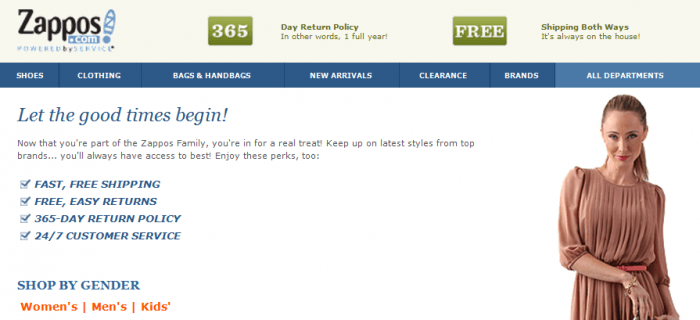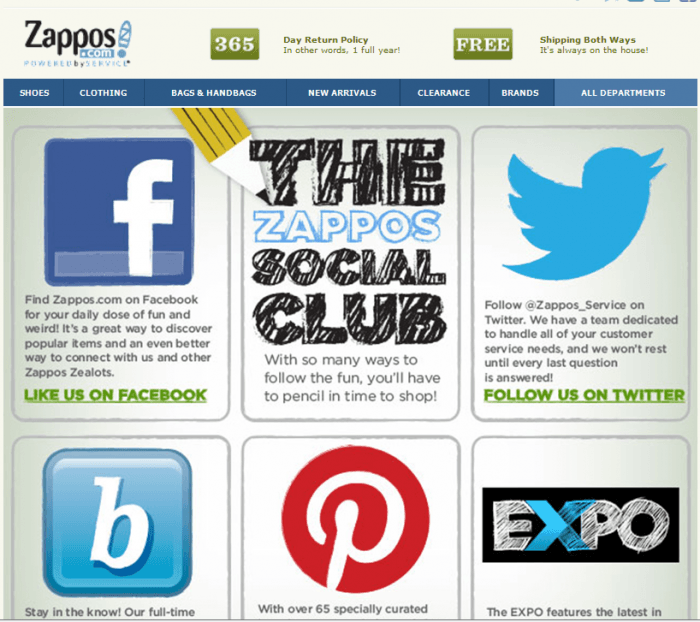 Recently we wrote about three tactics to accelerate your B2C email marketing: personalization, segmentation, and trigger messages. This time around, we’re going to look at the common tactic of discounting, and we’ll give you a scenario that links all the tactics together in a strategy.
Recently we wrote about three tactics to accelerate your B2C email marketing: personalization, segmentation, and trigger messages. This time around, we’re going to look at the common tactic of discounting, and we’ll give you a scenario that links all the tactics together in a strategy.
Don’t rush to discount
It’s common wisdom that new customers can be attracted by discounting, but you might wish to consider your discounting strategy from several angles.
- The new customer. Discounts may provide an incentive for someone to try a new product or service, and they can also be a good way to introduce a new business. The dark side of discounting is attracting that bargain hunter who strives to cut costs for every product at every turn. It’s unlikely that you’ll see much loyalty from them; when it’s time to buy again, they’ll spend their time browsing for the lowest offer. This kind of buyer thinks more about what they spend, and less about what they get for the money they pay.
- The long-term customer. Rewarding your loyal customers with a discount can enhance loyalty or pave the path for an upsell. These are the customers that don’t search for discounts but are happy to encounter them. Discounts for such customers can come in the form of free shipping, better terms, coupons for frequently purchased items, club membership, a bonus system, and so on.
Among those long-term customers, you might wish to offer varying levels of discounts or rewards. Here’s a tested qualitative way to segment those good customers:
Recency, frequency, monetary (RFM) analysis
The Pareto principle states that 80% of your business will come from 20% of your customers. Most RFM analysis is constructed to illuminate those “vital few.”
Such an analysis examines:
- How recently a customer has purchased (recency)
- How often they purchase (frequency)
- How much they spend (monetary)
Here’s a common method:
- Assign a ranking of 1 through 5 (5 being the highest) for each parameter
- For each customer, note the three parameter scores together (this is called a “cell”)
- Sort your database to determine which customers are “best”; the cell ranking of “555” is the highest possible
You could also segment by which customers buy your most profitable products, or which customers have provided the most referral business, or any other factors that make sense in your business and customer base. The ultimate point: Discounting is a tactic, not a strategy. Use it to serve larger goals.
Scenario: Three strategies for an online clothing store
Once you complete the segmentation of your customer base, the next step is to develop the emailing scheme for each segment. This online clothing store sells lower-priced clothing to younger (22-34) women, and advertises emphasizing affordable, on-trend clothing.
In this scenario, we have three simple segments:
- Subscribers – those who completed registration on the site, but haven’t placed any orders
- Prospects – those who completed registration on the site, added a product to the cart, but neither completed the order or canceled it
- Customers – those who completed registration on the site, added a product to the cart, and completed the order
1. Strategy for subscribers
Those who completed registration on a site, but haven’t placed an order.
There are four stages to this strategy:
Send #1 As soon as the registration is completed, send a trigger email thanking the subscriber for the registration. Provide brief information about the store, emphasizing benefits; outline when and why you will send messages. Given the target audience, it may be too soon to deploy any kind of questionnaire, but you might want to test something simple that gathers more information. (E.g., Are you planning a vacation soon?)
Send #2 Send an email two days after the registration is completed. Notify them of something; a promotion or special would be good. Be very specific as to the duration of the promotion, usually noting how many days it’s valid for and when it expires.
Send #3 Send an email after another week if no purchase has been made. Remind them of the benefits of shopping at your store. Consider also:
- Link to your blog or related content that may be interesting for a prospective customer, such as how to determine one’s size, new trends for certain occasions, what’s hot in accessories right now, and so on
- Comment on breaking fashion news, such as new designer or celebrity looks
Send #4. You may send standard messages during the following three months if a subscriber still hasn’t become your customer. This could be videos about fashion, notices about new collections arriving, new brands you’re introducing, information about specials, and so on.
After a certain length of time with no engagement at all, you could send a re-engagement email to determine whether the address is still good. If that gets no response, take the address off your list so you don’t harm your email sending reputation by emailing to non-responsive (or worse, spam trap) addresses.
2. Strategy for prospects
Those who completed registration on a site and added a product to cart, but haven’t completed the order or canceled it.
When someone adds a product to a cart but doesn’t complete the order, it’s called “shopping cart abandonment.” The strategy here is to bring that prospect back and convince them to complete a purchase.
Send #1 Send an email as soon as possible after you discover the shopping cart was abandoned. Politely ask if a customer faced any problems while trying to place the order. This could reveal whether your site has technical problems, or if there wasn’t enough information about the purchase process, goods, and/or delivery. Ask whether they need help to complete the order, and provide the contact data of a specific person (manager, customer support) who is available to get around the problem.
Send #2: Send the second email during the next two or three days. Remind the prospect that the product he or she liked (as evinced by them adding it to the cart) is still available, and that the price is still the same (was not raised). In this second email, you may also show related goods, discounted or not (e.g. buy these shoes, get 20% off the matching bag).
Send #3: The third email is sent in two to three weeks. Lay emphasis on free delivery or some other facet of the offer that you can control the timing period for. Then add a call to action that references when that offer ends.
All three of these emails should include images of the goods (remind the prospect what they wanted) and a link to the shopping cart so it’s very easy for the prospect to act on impulse and complete the order. The emails must be user friendly, clear, and confined to the item and uncompleted sales at issue; don’t muddy the water with advertising for other products. Your goal is to get this one sale closed or understand why the prospect has abandoned the shopping cart.
If the prospect doesn’t complete the purchase, and does not unsubscribe, it’s worth testing whether the prospect still likes you but just changed their mind about this one product. Try a series of informative and triggered messages:
- Information on available brands, new arrivals, top sellers, unique goods
- Date-specific greetings (Spring officially starts on March 21—what will you wear?)
- Trigger reactions to the prospect’s actions on your site (e.g., pages and products looked at, prices checked)
3. Strategy for customers
Those who completed registration on a site, added a product to a cart, and completed the order.
You’ve got lots of options with people who actually complete a purchase. Begin with an immediate order confirmation and that all-important “thank you” as soon as the purchase is made. Set service expectations with shipping dates and times. From there, you can plan any number of strategies, such as:
- Purchase history: “If you liked (what they bought) you may also like (related product)”
- Extend the usability of the purchased product: offer an accessory or an extended warranty
- Advice on trending products similar to what they purchased
- Information about the customer loyalty program
- Account information: password change, editing user profile data
- Do a survey and gain more information you can use to segment
The wheel has already been invented
Your business is unique, and your email marketing program should be unique, too. However, you don’t need to create an entirely new process in order to have a great campaign. Watch what shows up in your own mailbox that attracts your own interest, and watch what the high-profile masters do. Let’s look at Zappos, the world’s largest online shoe store.
Zappos email campaigns manage to be unobtrusive and engaging at the same time. Let’s study the emails that are sent to users who haven’t placed a single order on the site – 11 emails are sent during the eight days after the initial subscription.
The drip campaign begins with the triggered welcome email:
And continues on through a series of emails that begin by offering multiple ways to connect:
The subject lines vary, but all are fresh. A few examples:
- You Snooze, You Lose.
- Join The Zappos Social Club… No sign up necessary.
- All about you… finally!
- It’s going to be an action-packed summer…
- Act fast before these deals disappear!
- Let the good times begin!
- Don’t miss out!
- Get ready to be WOWed!
Each email’s footer contains one of the 10 basic Zappos family values:
- Deliver WOW Through Service.
- Embrace and Drive Change.
- Create Fun and A Little Weirdness.
- Be Adventurous, Creative, and Open-Minded.
- Pursue Growth and Learning.
- Build Open and Honest Relationships With Communication.
- Build a Positive Team and Family.
- Do More With Less.
- Be Passionate and Determined.
- Be Humble.
As you shop with Zappos and the company learns more about you, it can target the emails to the interests you display, personalizing those emails to you.
Summary
Email is still the most cost-effective marketing tactic you can deploy, offering a range of opportunities to attract customers, convert them, and satisfy their needs throughout the entire lifecycle. At the same time, cookie-cutter or insensitive email sending could harm the image of a company and spoil relationships with customers. Follow the guidelines of personalization, segmentation, and trigger messages; use discounting techniques sparingly and strategically; analyze and test constantly; and study the experience of leaders in the market. Every step you take on this journey gets you nearer your goals of higher revenue and better return on investment.
Want to learn how B2C marketers can use the B2B technique of webinars to enhance sales? Download The Benefits of Webinars for B2C Marketers, an Act-On white paper.



